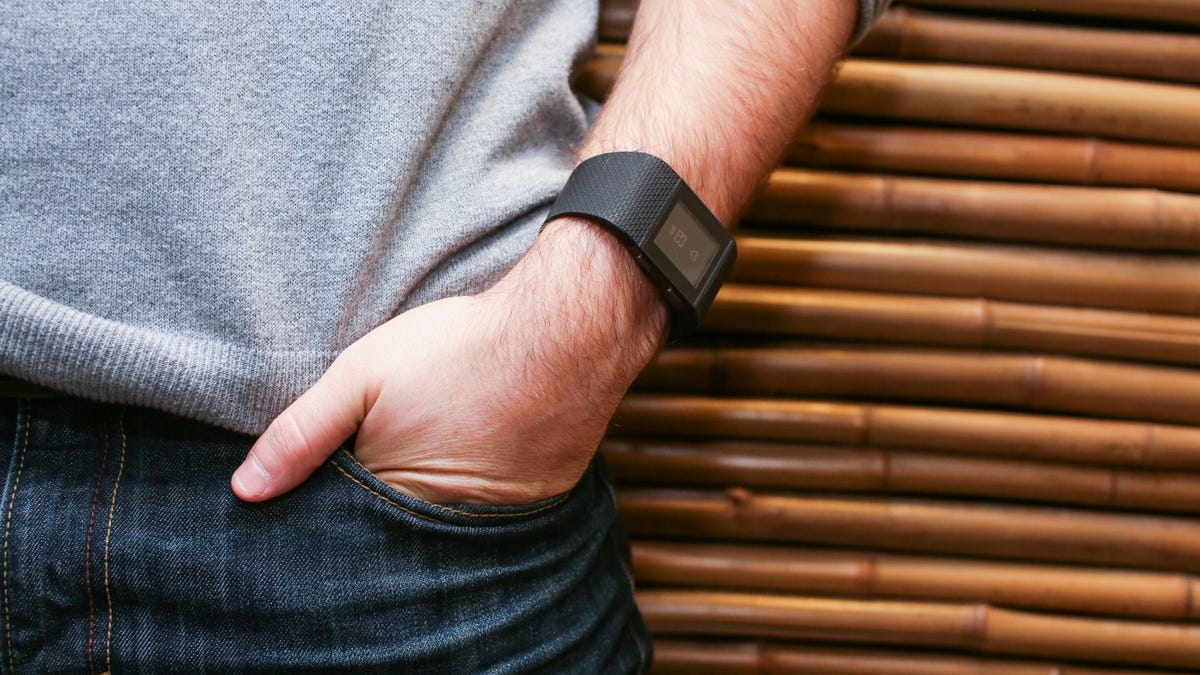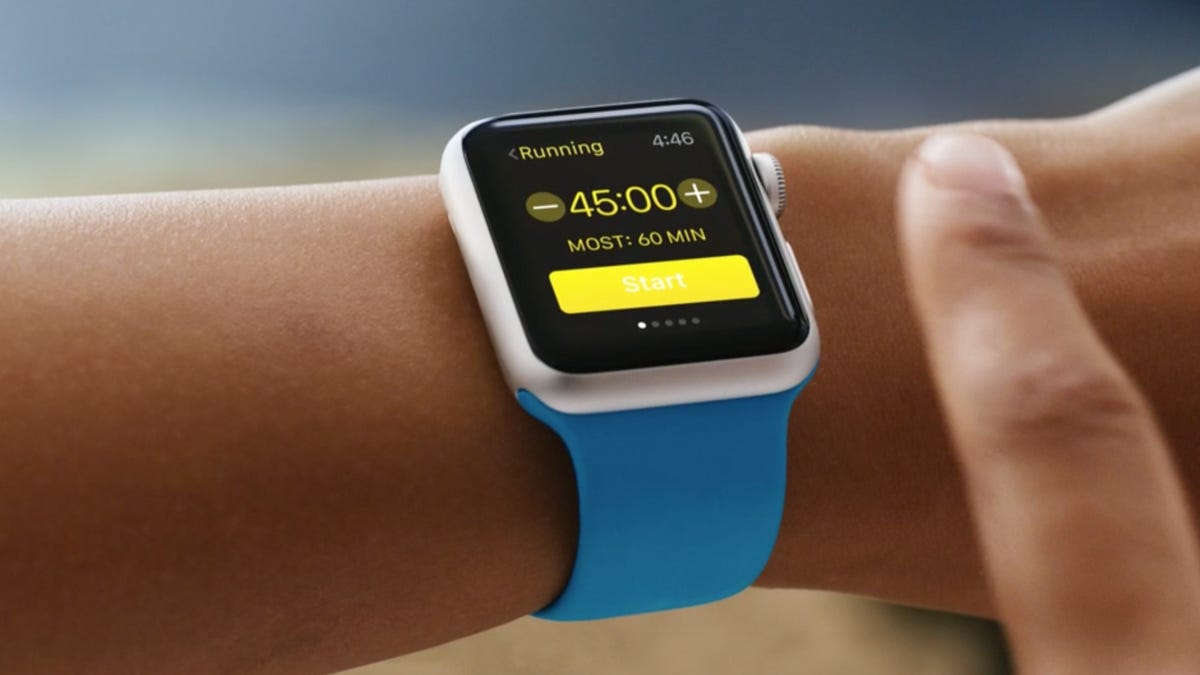
Sarah Tew/CNET
Fitbit is on track to be the first wearable tech-focused company to go public.
In a filing Thursday with the Securities and Exchange Commission, the 8-year-old startup — a leading maker of fitness- and health-tracking gadgets based in San Francisco — is seeking to raise $100 million in common stock on the New York Stock Exchange. The lead underwriters are Morgan Stanley, Deutsche Bank and Bank of America Merrill Lynch.
Wearable technology has hit a critical mass of mainstream attention this year with the launch of the Apple Watch and the trajectory of the burgeoning industry has investors and entrepreneurs paying close attention. Nearly every traditional technology company — from Intel and Microsoft to Samsung and LG — has a device for sale or a hand in the market. Not only has the area attracted the interest of tech titans, but it’s been a hotbed for rising startups like Fitbit and competitors Jawbone and Pebble, as well as an area of interest from an expansive set of traditional apparel and jewelry companies like watchmaker Fossil, fashion house Open Ceremony and clothing company Under Amour.
“It really signals that the fitness tracker category has finally penetrated the mass market,” said Wes Henderek, an industry analyst with the NPD Group. “It’s no longer just a niche category and is appealing to a much wider range of consumers who are not fitness buffs.” Henderek said that Fitbit, as the most dominant player in the category by a wide margin, is trying to nail its IPO timing to ensure it can grow even faster.
Founded in October 2007 by James Park and Eric Friedman, Fitbit makes a wide range of simple, colorful devices meant to be clipped or strapped to the body for counting steps, measuring sleep activity and monitoring workouts. Fitbit also makes companion software for smartphones and a Web application that both display stats, offer insights and training tips and let users input what they ate throughout the day to track caloric intake and other daily health metrics.


Sarah Tew/CNET
The company has grown to 579 employees under Park, acting chief executive, and Friedman, the chief technology officer, as of March 31. Over the course of five rounds of investment, Fitbit has taken in $83.5 million in funding from SoftTech VC, Foundry Group, Felicis Ventures, True Ventures, SoftBank Capital, Sapphire Ventures and Qualcomm Ventures.
Fitbit’s devices include the Charge HR wristband and the Surge smartwatch, which began shipping in January, and a slew of other, cheaper gadgets from as low as $60. The company said it sold almost 11 million devices last year, a 142 percent increase from 2013, and rung up $745.4 million in sales, a 175 percent increase from the year prior. According to industry tracker the NPD Group, Fitbit sold the most activity trackers through retail channels in the US last year, capturing a 68 percent share of the market by dollars, up from 58 percent in 2013.
In the last three months, the company says it counted 9.5 million users who either own a $50-a-year Fitbit Premium membership; paired a wearable device or a Fitbit Aria scale with a Fitbit account; or logged at least 100 steps with a wearable device or took a weight measurement with an Aria scale. Fitbit also lumps in FitStar Premium memberships into its active user count; in March, Fitbit acquired the personal-training app, which counted 2 million users on Apple’s iOS platform at the time.
Apple Watch looms large
Though its growth is strong, Fitbit is entering a market flush with big-name competitors, including Apple, Samsung, LG and Microsoft, and fast-growing fellow participants like Garmin, Jawbone, Misfit and others.
“We expect competition in our market to intensify in the future as new and existing competitors introduce new or enhanced products and services that are potentially more competitive than our products and services,” Fitbit wrote in a section of its filing labeled “risk factors.”
Apple has marketed its Apple Watch as a comprehensive health and fitness device on top of its capabilities as an extenuation of the smartphone for phone calls, texts and a variety of other features ranging from music and Instagram to GPS and Twitter. Fitbit has designed its devices to be no-frills fitness trackers, choosing not to include color screens and eschewing a proprietary mobile operating system that would allow its devices to do much more than show steps counted, tell the time and show simple smartphone notifications.


Apple
Competitors like Pebble and Samsung have developed their own software to compete with Apple’s new smartwatch OS and Google’s prevalent Android Wear, which runs around half a dozen devices on the market today.
“Some of our competitors may aggressively discount their products and services in order to gain market share, which could result in pricing pressures, reduced profit margins, lost market share, or a failure to grow market share for us,” Fitbit concluded.
Henderek says that Fitbit is in a good position to fend off even companies like Apple. “Fitbit has tremendous brand equity,” he said, adding that Fitbit is one of the only wearable tech makers customers seek out by name rather than by the feature set of its products.
Yet Fitbit will only face more pressure in the future, he added. “The market has become much more competitive in terms of the number of products and innovation,” Henderek said. “It has become much harder for Fitbit to maintain an innovative product edge in this market, even though it does have a wider product range today than six months ago.”
Smartwatches pose the biggest risk to Fitbit, say industry analysts. The global fitness wearable market, which includes fitness wristbands, sport watches and smart garments, is expected to shrink next year from 70 million units sold to 68 million, according to a November 2104 report from analyst firm Gartner. Smart-wristband shipments are expected to fall by 15 percent to 17 million units, while smartwatches are expected to jump 17 percent to 21 million shipments, eclipsing the former as the most successful wearable design to date.
The problem? Fitness wristbands, as popular as they have been so far, just don’t do enough to excite consumers when compared with devices like the Apple Watch and Motorola’s Moto 360 smartwatch — or do very little that a smartwatch can’t do and more. “Half the people who would have bought a [fitness] wristband will buy a smartwatch instead next year,” Gartner analyst Angela McIntyre concluded in the report.
There’s also the factor of how useful customers find activity trackers over time. In April, NPD Group found that around 40 percent of people stop using such a device within six months of purchase. The same study said analysts expect the fitness tracker market to peak at 32 million unit sales by the end of 2016 after four years of substantial growth.



